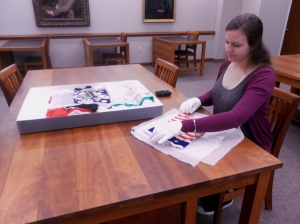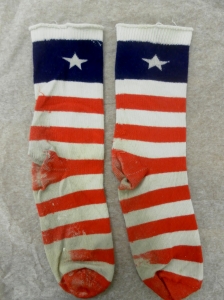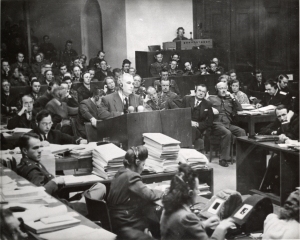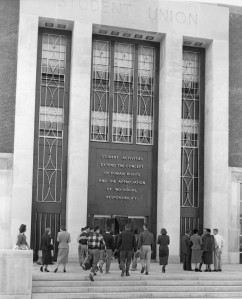In her new series Through the Lens of an Anthropologist, undergraduate Anthropology major and writing intern Carey MacDonald will analyze artifacts found in the collections of Archives and Special Collections. ‘By asking a set of questions, I intend to reveal and highlight many intricate patterns of human behavior, such as social actions and customs, and the ways in which those patterns of behavior are represented in certain artifacts.” — Carey MacDonald

Clothing, as a fundamental, human form of expression, is symbolic of our cultural, social, and physical environments, as well as of our experiences and beliefs. T-shirts, jerseys, hats, pins – these things are worn as distinct symbols of an individual. But what about a pair of socks?
Abbott “Abbie” Hoffman, the Massachusetts-born activist and co-founder of the Youth International Party, or the Yippies, of the 1960s and ‘70s, is best known for his unabashed and public criticism of American government policies and politicians. He used calculated political theater to engage young people in the political and social issues of the time and to organize them in the effort to reform the government and the nation. Hoffman’s revolutionary ideology manifested itself in his own self-expression; he publicized his ideas by way of media coverage of his demonstrations, as well as through the very clothes he wore on his body.

In the collection of the Hoffman Family Papers we see that Jack Hoffman, Abbie’s younger brother, maintained regular correspondence with Abbie throughout his years of activism. Jack later gained many of Abbie’s possessions, such as the aforementioned t-shirts, political pins, and, naturally, a dirty, well-worn pair of red, white, and blue socks that resemble the American flag. The socks’ knitting is worn away in the toes, heels, and calves, indicating their habitual use. Since he frequently wore them and kept them long enough for them to eventually reach his brother, these red, white, and blue socks must have meant something to Abbie. And they certainly mean something to us today about his life and his activism.
At the 1968 Democratic National Convention in Chicago, Abbie and eight other leaders and their Yippie followers held a demonstration against the war in Vietnam and pushed for social and political reform in Washington. In an amateur video taken of Abbie discussing the forthcoming demonstration in Chicago, he articulates his plan to take social action at the Convention for the exact purpose that there would be extensive media coverage of the goings-on. He expected that every hour or so during the televised Convention the cameras would cut from the politicians’ speeches to the Yippies’ demonstration, and the viewers would immediately be interested in what they were doing. In preparation for the demonstration, the mayor appeared on television constantly and stationed police forces and Secret Service agents in the city. In interviews with journalists prior to the event, Abbie likened the whole scene to an exciting football game, like the Rose Bowl. By implementing dramatic, theatrical tactics to capture the public’s attention, Abbie and his Yippie friends could deliver their message in the spotlight.
However, to the Mayor and politicians, the demonstration at the DNC was viewed as a violation of the Anti-Riot Act that had been established in April 1968 after the assassination of Martin Luther King, Jr. Similarly, the American flag t-shirt that Abbie wore during the ensuing trial of the demonstration leaders, who were known as the Chicago Seven, was perceived by the judge as a desecration of the flag, a national symbol that is meant to be revered. By practicing these forms of political theater, Abbie Hoffman managed to create “an advertisement for revolution,” as he calls it in his 1968 book, Revolution for the Hell of It. As for his red, white, and blue socks, it is very possible that he wore them to be viewed as a defilement of the flag. Or, after he was acquitted of conspiracy in 1973, he may have worn them during the years that he was on the run after jumping bail for his arrest for cocaine possession.
Yet it is also conceivable that he wore them to promote his image of a new, reformed America. He could have been expressing his patriotism and hope to his fellow Yippies and Americans, and since he personally knew he was wearing them, they could have symbolized, for himself, his idealism and belief in social change.
Carey MacDonald, writing intern






